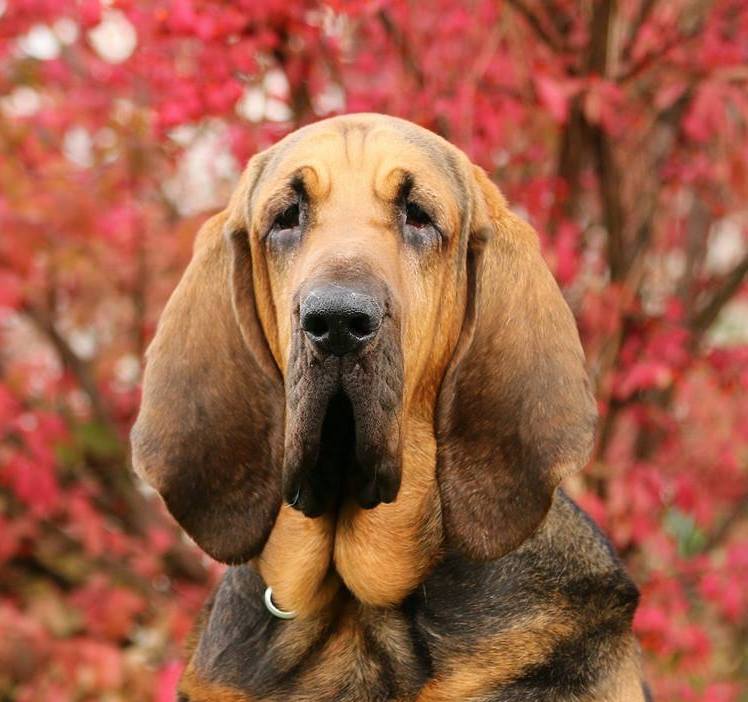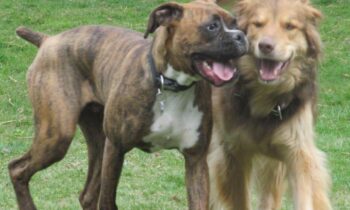
You’re walking with your dog or dogs on leash when a loose dog (or dogs) approaches you. Its owner or owners are in the distance. What’s your best shot at preventing the loose dog/s from interfering with you and your dog/s?
I polled dog owners and dog trainers on Facebook, and they all agreed—this happens all the time. No matter what your level of expertise with dogs and dog handling, it’s always scary, because you can’t know what will happen next.
Susanna J. Sturgis: My dog (80-pound malamute) is well trained (Rally O champ!) but also reactive, so we’ve had a lot of experience with this over the years. In general, there’s no way to control either the loose dog(s) or the (often clueless) owner. I focus on using treats to keep my dog’s attention on me as we continue on our way.
My guy has become more comfortable over the years (he’s now 9 1/2) with loose dogs running at him. In the overwhelming majority of cases, the other dog(s) have been PITAs but not aggressive. One exception is a yellow lab in my neighborhood who has gotten loose twice and come at my Travvy with teeth bared. In both cases, the owner was fairly close by and I was able to keep myself between the lab and Trav (who was doing everything he could to avoid a fight) until she showed up.
Tery McConville: My quick assessment would include the approaching dog(s) and [their] possible intent, then [the] owner (if one is around) and how much control/influence they have. Then I look to my dog(s) and their assessment of the incoming, then [find] available exits. All of this is contextual, so most times I don’t move at all. I do sit on on a rather large, heavy, and maneuverable device, though, and have interrupted fractious sorts by splitting them from my dogs. That usually gets eyes on me pretty quick.
Cricket Mara: Time is a factor, as split-second decisions are often required. If I see the dog in the distance, I have many more options. When startled (I heard nails on the pavement behind us, approaching fast), I followed my gut . . . wheeled around so my dog was behind me and let out a loud “Hey!” then maintained an assertive posture and commanded “Go Home!” Luckily, [the] owner came quickly to retrieve [the] escaped German Shepherd. Most of my loose-dog experiences have been without owners present, so “Go Home” works well.
Marcy Rauch: Years ago, in a leash-only New York state park. I saw people coming toward me with three pitties moving faster than they would be if leashed. My rescue Aussie, Bandit, had made huge strides, but three dogs rushing up to him on leash was not going to go well. I screamed “Get your dogs.” They answered, “They’re friendly.” I responded, “Mine’s not, and the dog that rushed him last week had to go to the ER.” They freaked and frantically got their dogs back and leashed. We ended up having a great discussion. I used it as a teachable moment.
Cherie Marshall: This actually happened to me while I was walking with Fergus, a bloodhound (145 pounds of muscle), when two dogs came flying across the park toward us. Of course, I knew I couldn’t pick Fergus up, and I couldn’t avoid the confrontation once Fergus caught sight of the two dogs charging towards us. The only thing I could think of was to be more “in charge” than any of them. So we—Fergus and I—stood still and faced the charging dogs. As they got closer, I stepped forward toward them with authority and yelled “NO!”
Fergus acted like, “Wow, you got this. I’ll just stay one step behind you for backup in case you need me.” And the other two dogs stopped immediately! I think it scared them that I was not backing down or turning away—if I had to take them on, then so be it. Nothing was going to hurt Fergus, so they had better back OFF! They did not come any closer, and their owner actually came bounding across the park after them. I never turned my back on them.

Photo by Cherie Marshall
Timothy Page: One day a few summers back, I left the restaurant we had stopped at. As I walked out, I noticed an SUV with the back open, exposing two crates with dogs inside them. I didn’t think too much about it. I took my little Chiquis out of the car, on leash, to give her a chance to relieve herself. In a flash, one of the huge dogs in those crates came racing out, obviously with my chihuahua in his sights. The man yelled for me to pick up my dog. His dog was coming so fast, there was no time. I swung my dog by her leash up into the air and out of reach, then caught her. Saved. That was a big scare for both of us. The man, of course, apologized that he hadn’t secured the crate and told me he knew this one dog would attack, but he hadn’t seen us in time to warn us or secure the crate.
It’s another reason to use a harness. If my dog had worn only a collar, I’d have been afraid of any injury that might have happened to her throat or spine.
Lonnie Evans Pearson: Yelling at the dog didn’t do me any good when a dog came across the street directly to my bigger dog and started a fight. I grabbed both collars and held them apart—on my stomach with my arms spread apart—until the lady came to get her dog. Totally took me by surprise, skinned my knee up. I was just stunned by the whole thing. Glad we don’t live in that neighborhood any more. Too many animals!
Donna Weidert: This happened to me with a coyote while I was walking my border collie. Jack was off lead and I was between him and the coyote. I started walking very fast toward my dog, away from the coyote. I caught up with Jack, leashed him, turned around (the coyote was now much closer), and used my ”big voice” on the coyote. It stopped. That allowed Jack and me to get to our car.
Many of the dog owners and dog trainers responding to my question had some simple tips:
Lucy Phillips: Shout to the owner to recall their dog (if you can see the owner). If not, throw some treats away from you to distract the other dog, then get away quick!
Linda Ehrenworth: Throw treats at the loose dog or pop out an umbrella.
Flacortia Rosiea: Change direction if possible. Otherwise, use a pointy-tip walking stick to great effect.
Micha Michlewicz: Move your own dog behind you (preferably trained well beforehand). Stand stiffly and make hard eye contact.
Christine Hale Vertucci: I had success once with yelling “SIT!” at a off-leash dog barreling toward my reactive dog. I couldn’t believe it worked.
Sally Bradbury: I’d just concentrate on my own dog and move away briskly and calmly, keeping him focused on me, usually with a tug toy.
Olivia L. Bravo: I would have my dog keep its eyes on me. If the dogs look like they are menacing, I would pick up my dog, turn away from the approaching dogs, and tell the owners to control their animals.
Hugh Imhof: Stay calm and don’t yell. It just gets the dogs more excited.
Erin E James: I always have a treat pouch, so I rely on the old treat-throwing trick. But if that doesn’t work, I’m out of luck.
Kathy Smith: My focus goes immediately to my dog. I get his attention on me and turn and walk away. If I have an opportunity, I will yell a large “Nah-uh!!!” at the offending dog.
Jill Gibbs: Throw dog cookies at the dog’s face. The shock will stop its forward movement . . . and you can hope it will eat the cookies.
Harald Groenen: I shorten my dog’s leash, bring her closer to me, and present a large singular entity. (The shorter lead also makes her more apt to stay calm and follow commands.) If the other dogs move closer, I move my dog so I am between her and the other dogs. I try to keep her focused on moving with me away from the area.
Dia Barney Nonaka: Chuck a bunch of delicious treats to your right, lure your dogs to your left. Don’t look back.
Ronald Schumann: I carry big hiking sticks. In such a situation, I would secure my dog at my side, make myself large, and brandish the sticks.
Sherry Al-Mufti: Get outta Dodge quickly and calmly.
Nan Arthur: Carry a small pop-out umbrella that opens fast, can scare, and gives you a weapon to boot. Should be practiced with your own dog first.
Some suggestions work well for some dogs and not for other dogs. Here’s a discussion among trainers about yelling and making noise at approaching off-leash dogs:
Beth Fabel: I rather aggressively step out in front of my dogs, stomping my feet, waving my hands, and telling [the approaching dogs] to shoo. Most dogs understand that body language and, if they are merely coming to visit, it will usually make them go away. Also, if their humans see it, they think I’m a horrible mean person and call their dog back.
Micha Michlewicz: I’d be worried about it further working up an already over-excited dog. Does it have that effect?
Jill Gibbs: This has caused my mild-mannered Flatcoat to feel threatened. He thought he needed to protect me.
Beth Fabel: It hasn’t for me. But my dogs are not in any way protective. Also, while I’m clearly stepping toward them, my body language is saying “back off.” I’m not super loud or violent about it, so I haven’t seen it turn a dog defensive. Mostly they’re just confused that I don’t want them to visit.
What about using pepper spray or another deterrent on the loose dogs as they approach?
Kathy Nelson-Longwell: I always carry pepper spray with me and I’ve been walking dogs for 10 years. I had a very bad interaction once where I didn’t even have time to get to my pepper spray. Thankfully, the dog I was walking survived. I have had to use the pepper spray only once when a dog came charging.
Nancy Coburn Rich: Pepper spray has worked a couple of times for me.
Debby McMullen: My go-to is always having a can of Spray Shield and yelling very loudly to “Get your dog!” The latter is something that my dogs know means look at me and you get food.
Lauren Fetterman: Spray Shield in its path.
Tamara A. Howard: My dogs are trained to automatically get behind me to avoid any potential conflict. Wind direction being a positioning factor, citronella spray and mace are two of my go-to options; a Taser is my other. Sounds harsh, I know; however, I am my dogs’ protector and advocate and I take their safety and well-being seriously.
Barbara De Groodt: I always carry Spray Shield, the old Direct Stop, a canned air horn, and a Doggie Don’t. I’ve tried treat–tossing, but unless the dog isn’t too intent, I find it’s not successful. It’s horrible to have to [use the deterrents], but . . . I also have my dogs behind me and I step forward with a very aggressive posture.
Val Hughes: Could you describe a Doggie Don’t?
Barbara De Groodt: It sounds like a Taser. Kind of a static sound. It’s not [painful], it’s just sound, and because it’s so different, I find it very effective. Have used it twice with success.
What about throwing treats at the oncoming loose dogs? Many trainers advocate for that solution, but it’s important to note that your own dogs must first be trained not to pursue the treats you’ve thrown, or they could get into big trouble competing for those treats with the unknown loose dogs.
Virginia Rhodes Korn: I don’t carry spray or treats. I’ve never experienced a vicious dog attack, but several dogs have tried to follow us or barked at us from a yard. I have always moved to the other side of the street, positioned myself between me and the loose dog(s), and tell them to “go home” or “no, stay.” If I threw treats, my dogs would go for the treats.
Susanna J. Sturgis: I wouldn’t throw treats at the other dog. My very food-motivated guy would probably go for them, and since he’s got strong resource-guarding tendencies, he and the other dog might end up fighting for the treats.
Shannon Thier: I don’t throw treats. I haven’t found that deters a dog focused on getting to my dog and me, especially if the dog was treat-trained. Then, in the slim chance it does work, I’ve just potentially reinforced the oncoming dog’s behavior. I’d rather reinforce my dog for staying calmly behind me.
There is no one answer to avoiding loose dogs when you’re walking with your own dog or dogs on leash. Choosing to walk in areas where other walkers keep their dogs on lead is getting to be more and more difficult in many settings, both urban and rural. Leash laws aren’t stopping many owners from ignoring public safety and common courtesy. Animal control agencies don’t have the funding to patrol the parks and streets for scofflaws; citations are usually given only after the damage has been done in an on-lead/off-lead dog confrontation.
Whatever your choice of reaction or deterrent when loose dogs approach, remember the importance of training before an emergency with your own dog or dogs.
▪ Train them to react in their most cooperative manner when loose dogs come near.
▪ Accustom them to any loud or scary actions you might need to take to keep loose dogs away.
▪ Make sure your own dogs’ appropriate reactions are generously rewarded.
▪ Practice, practice, practice—every single day.



